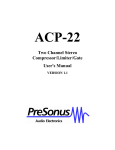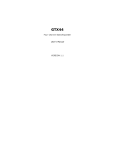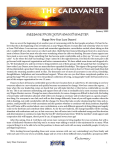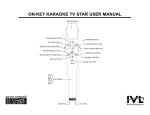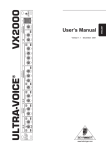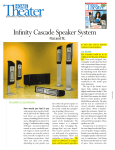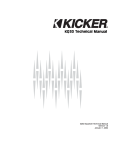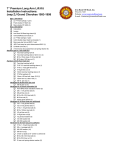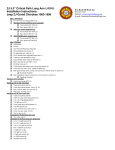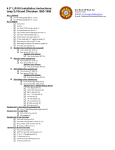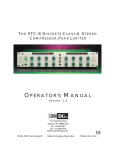Download CL44 Manual
Transcript
CL44 Four Channel Compressor/Limiter User's Manual VERSION 1.1 PreSonus Limited Warranty PreSonus Audio Electronics Inc. warrants this product to be free of defects in material and workmanship for a period of one year from the date of original retail purchase. This warranty is enforceable only by the original retail purchaser. To be protected by this warranty, the purchaser must complete and return the enclosed warranty card within 14 days of purchase. During the warranty period PreSonus shall, at its sole and absolute option, either repair or replace, free of charge, any product that proves to be defective on inspection by PreSonus or its authorized service representative. To obtain warranty service, the purchaser must first call or write PreSonus at the address and telephone number printed below to obtain a Return Authorization Number and instructions of where to return the unit for service. All inquiries must be accompanied by a description of the problem. All authorized returns must be sent to the PreSonus repair facility postage prepaid, insured and properly package. Proof of purchase must be presented in the form of a bill of sale, canceled check or some other positive proof that the product is in within the warranty period. PreSonus reserves the right to update any unit returned for repair. PreSonus reserves the right to change or improve design of the product at any time without prior notice. This warranty does not cover claims for damage due to abuse, neglect, alteration or attempted repair by unauthorized personnel, and is limited to failures arising during normal use that are due to defects in material or workmanship in the product. Any implied warranties, including implied warranties of merchantability and fitness for a particular purpose, are limited in duration to the length of this limited warranty. Some states do not allow limitations on how long an implied warranty lasts, so the above limitation may not apply to you. In no event will PreSonus be liable for incidental, consequential or other damages resulting from the broach of any express or implied warranty, including , among other things, damage to property, damage based on inconvenience or on loss of use of the product, and, to the extent permitted by law, damages for personal injury. Some states do not allow the exclusion of limitation of incidental or consequential damages, so the above limitation or exclusion may not apply to you. This warranty gives you specific legal rights, and you may also have other rights which vary form state to state. This warranty only applies to products sold and used in the United States of America. For warranty information in all other countries please refer to your local distributor. Limited Warranty Outside of The U.S. PreSonus Audio Electronics produc ts are warranted only in the country where purchased, through the authorized PreSonus distributor in that country, against defects in material and workmanship. The specific period of this limited warranty shall be that which is described to the original retail purchaser by the authorized PreSonus dealer or distributor at the time of purchase. PreSonus does not, however, warrant its products against any and all defects: 1) arising Out of materials or workmanship not provided or furnished by PreSonus, or 2) resulting from abnormal use of the product or use in violation of instructions, or 3) in products repaired or serviced by other than authorized PreSonus repair facilities, or 4) in products with removed or defaced serial numbers, or 5) in components or parts or products expressly warranted by another manufacturer. PreSonus agrees, through the applicable authorized distributor, to repair or replace defects covered by this limited warranty with parts or products of original or improved design, at its option in each respect, if the defective product is shipped prior to the end of the warranty period to the designated authorized PreSonus warranty repair facility in the country where purchased, or to the PreSonus factory in the U.S., in the original packaging or a replacement supplied by PreSonus, with all transportation cost and full insurance paid each way by the purchaser or owner. All remedies and the measure of damages are limited to the above services. It is possible that economic loss or injury to person or property may result from the failure of the product; However, even if PreSonus has been advised of this possibility, this limited warranty does not cover any such consequential or incidental damages. Some states or countries do not allow the limitations or exclusion of incidental or consequential damages, so the above limitation may not apply to you. Any and all warranties, express or implied, arising by law, course of dealing, course of performance, usage of trade, or otherwise, including but not limited to implied warranties of merchantability and fitness for a particular purpose, are limited to a period of two years from either the date of original retail purchase or, in the event no proof of purchase date is available, the date of manufacture. Some states or countries do not allow limitations on how long an implied warranty last, so the above limitations may not apply to you. This limited warranty gives you specific legal rights, and you may also have other rights which vary from state to state, country to country. PreSonus Audio Electronics, Inc. 7257 Florida Blvd. Baton Rouge, LA 70806 225-216-7887 www.presonus.com Table of Contents 1 Overview 1.1 Introduction 1.2 Features 2 Controls & Connections 2.1 Front Panel Basic Layout 2.2 Compressor & Limiter Controls 2.3 Bypass & Link 2.4 Patch Panel 2.5 Power 3 Basic Setup & Applications 3.1 Basic Applications 4 Technical 4.1 Specifications A Appendix 1 A word about compression... 2 Troubleshooting 1.1 INTRODUCTION Thank you for purchasing the PreSonus CL44 four channel dynamics processor. This processor was designed using state of the art components to deliver crystal clear compression and limiting for an infinite period of time. We believe that it is an exceptional sounding unit as well as an exceptional value. Feel free to contact us at 1-800-750-0323 anytime for any reason whatsoever. We value your suggestions and your comments! Please pay close attention to how you connect your CL44 to your system. Improper grounding is the most common cause of noise problems found in studio or live sound systems. We urge you to at least scan this manual before hooking up your CL44 to become familiar with its features and various applications. Good luck and enjoy your CL44! 1.2 FEATURES The following is a summary of your CL44's features: Full Featured Compressors/Limiters Each channel of your CL44 contains an audio compressor and limiter. You have broad control over threshold, ratio, attack, and release for each compressor. You can select between auto or manual attack and release curves (refer to the application section of this manual for a quick tutorial on compression and limiting). The compressor will prove to be very useful in many situations such as recording instruments or vocals that vary in loudness. Channel Linking Using the Link function, you can link together two channels of the CL44 for stereo operation. When linked, the processors follow the setting of the linked channel to the left, which becomes the master. When two channels are linked, the sidechains are summed. Separate Bypass and Gain for Each Channel All four channels have a separate bypass for listening to 'before and after' performance tests and a gain control to make up for any output level lost due to compression of the signal. Insert Sidechain on Each Channel Each channel of your CL44 was designed with a special jack for spectral processing, compression keying and ducking applications. Sidechaining is useful for removing annoying sibilance from vocal tracks (de-essing) or automatically ducking tracks behind a narrator for 'auto mixing' a service, broadcast or performance. Optical Mode The CL44 has an optical compressor emulation mode. This feature alters the signal’s characteristics to sound like the signal was processed using a vintage compressor. Compander The CL44 has a compander on each channel. The compander works like an upward expander. Essentially, it increases the level of the signal that is below the threshold according to the percentage specified on the knob. The range is from 0% to 100%. Balanced XLR and Unbalanced 1/4" Tip/Ring/Sleeve Input/Output Your CL44 accepts XLR connectors for balanced or a single 1/4" TRS for unbalanced inputs and outputs. +4dBu or -10dBV Insert Switch The operating level of your CL44’S inserts can be switched between +4dBu (pro levels) to -10dBV (consumer levels) for ease of use with external equipment in any situation. To Get Help Call Us: 1-800-750-0323, 9AM to 5PM, CST Visit our World Wide Web site: http://www.presonus.com Email Us: [email protected] 2.1 FRONT PANEL BASIC LAYOUT Notice that the front panel is divided into four identical sections. These are the four signal processing channels of the CL44. Each channel contains: Compressor/Limiter Lo Filter Compander Gain (Output Control) Link & Bypass Control Optical and Auto Mode 2.2 COMPRESSOR/LIMITER CONTROLS Lo Filter The setting determined by the lo filter control allows signals passing through/above the selected frequency to be acted upon by the compressor while the frequencies below the selected frequency are rolled off and ignored by the processor. The Lo frequency control is variable from 20 Hz to 12 kHz with the twelve o’ clock position being 2 kHz. An example of the Lo filter in use would be to set the cut-off frequency at 4 kHz to reduce annoying sibilance (SSss’s) in a vocal performance. The compressor will de-accentuate the frequencies above the selected 4 kHz while the frequencies below 4 kHz are allowed to pass. Remember, the Lo filter effects the processing, but the audio path remains full range. Threshold The Compressor threshold sets the level at which the onset of compression begins. When the signal is above the threshold setting, it becomes 'eligible' for compression. Turning the threshold knob counter-clockwise causes more of the input signal to become compressed if you have a ratio setting of greater than 1:1. Ratio Ratio sets the compression slope. This can be defined as the output level versus the input level. For example, if you have the ratio set to 2:1, any signal levels above the threshold setting will be compressed at a compression ratio of 2:1. This means that for every l dB of level increase into the compressor, the output will only increase 1/2dB, thus producing a compression gain reduction of 0.5dB. As you increase the ratio, the compressor gradually becomes a limiter. A limiter is defined as a processor that limits the level of a signal to the setting of the threshold. For example, if you have the threshold knob set at 0dB, and the ratio turned fully clockwise, the compressor becomes a limiter at 0dB. This means that the signal will be limited to an output of 0dB regardless of the level of the input signal. Compander The Compander works like an upward expander. Essentially, it increases the level of the signal that is below the threshold according to the percentage specified on the knob. The range is from 0% to 100%. Compander is derived from a combination of the word “compressor” and “expander”. The effect a compander circuit achieves is that of restricting the dynamic range of the signal. The compressor prevents the transient of the signal from going above a setting while the expander ensures that the signal is boosted below a predetermined point. This results in the signal being maintained within a very restricted range without the loss of any information. The signal “seems” louder without actually going above the level determined by the compressor. Apparent loudness is the result. The ratio selected for the compressor determines the amount of activity of the expander on the incoming signal. Attack Attack sets the speed at which the compressor 'acts' on the input signal. A slow attack time (fully clockwise) allows the beginning envelope of a signal (commonly referred to as the initial transient) to pass through the compressor uncompressed, whereas a fast attack time (fully counter-clockwise) subjects the signal to the ratio and threshold settings of the compressor more rapidly. The Attack control is only active when the Auto button is not pushed in. When the auto button is pushed in, the compressor automatically determines the appropriate attack time for compression. Release Release sets the length of time the compressor takes to return the gain reduction back to zero (no gain reduction). Very short release times can produce a very choppy or 'jittery' sound, especially in low frequency instruments such as a bass guitar. Very long release times can result in an over compressed sound, sometimes referred to as 'squashing' the sound. All ranges of release can be useful at different times. You should experiment to become familiar with the different sound possibilities. (Refer to the applications section of this manual for some ideas.) The Release control is only active when the Auto button is not pushed in. When the auto button is pushed in, the compressor automatically determines the appropriate release time for compression. Limiter The limiter on the CL44 has a fixed compression rate of greater than 20 to 1, and a fast fixed attack and release. The limiter knob allows you to set the threshold level. Optical Engaging the Optical mode applies a DSP emulation of an optical transfer curve to the signal. This transfer curve provides the desirable audio qualities derived by using vintage optical limiters. Optical mode is especially effective for adding warmth and presence to a signal. Adjacent channels are link-able allowing the operator of the CL44 the option of having a stereo optical limiter for use on “mix-down” which would provide a very pleasant analog quality to the signal. Vocal performances can benefit significantly from the pleasing quality provided by the emulation of the transfer curve of an optical limiter. Auto When pushed in, the auto button places the compressor in automatic attack and release mode. The attack and release knobs become inoperative and a pre-programmed, input dependent attack and release curve is used. Gain Compressing a signal usually results in an overall reduction of output level. The gain control allows you to restore the loss in output level due to the activity of the compressor on the signal. (Like readjusting the volume.) 2.3 BYPASS & LINK Bypass Activating the bypass effectively removes all processing being performed by your CL44 and returns the signal to unity gain. You should use bypass often when setting up your CL44 to compare the 'before and after' results of the signal processing affecting your audio signal. Bypass affects both the gate and the compressor. When in Bypass, the Link function is disabled. Link Engaging the Link button causes the channel to the left becomes the master controller of both channels. The channel to the right’s controls become disabled and metering becomes summed left and right, i.e. stereo mode. IMPORTANT: When two channels are linked (link button pushed in), all of the channel to the right’s controls are inactive. 2.4 PATCH PANEL (BACK) Input/Output The input/output jacks are unbalanced tip/sleeve or ring/sleeve connectors or balanced XLR connectors. The XLR inputs/outputs can handle up to +24dBu unbalanced or balanced. +4/-10 Switch This switch adjusts the insert operating level of the sidechain of your CL44 when it is connected to line level (0dB = -10dBV) gear. With the switch in the '-10' position, the sidechain signal is raised internally. The main audio path is not effected other than the processing level. When the switch is in the '+4' position, the signal is not changed since this matches the internal sidechain operating level of your CL44. The +4/-10 does not change the audio level through the CL44. This function may also be useful in creating special effects with the compressor by 'overcompressing'. It is important to remember that Pro Gear has a hotter +4 level, whereas consumer gear runs at the lower level of -10. Flip Button The Flip Button ‘flips’ the tip and ring (between SEND/IN and RETURN/OUT) on the ¼” jack to match the wiring preference of your console. Sidechain Insert The sidechain jack on each channel interrupts the signal that the compressor is using to detect the audio signal for processing. When no connector is inserted into this jack, the input signal goes directly to the compressors control circuitry (normaled). When a connector is inserted into this jack, the signal path is broken. If you have inserted a tip-ring-sleeve connector, the input signal is sent back out of the CL44 via the ring of the connector. This signal can then be processed by an equalizer for example to reduce sibilance (de-essing) in a vocal track. The signal is then returned to the unit via the tip of the connector. The signal sent to the tip could also be that of a narrator or vocalist. In this application, the audio that you are passing through the compressor will automatically 'duck' when the narrator speaks or vocalist sings. 2.5 POWER Power Connection The power jack on your CL44 accepts a standard IEC cord like those found on most computers and professional recording equipment. Your CL44 contains a custom built in power supply, no wall wart. This way you can be assured of clean power combined with rugged construction that has been designed to last! Power Switch I = ON, 0 = OFF. 3.1 BASIC APPLICATIONS Example Setup Compressing a Voice or Vocal Track Probably the most common use of a compressor is to limit the dynamic range of a vocalist during a live performance or a recording. It is almost always necessary to compress a vocal take during a recording session. Most vocalists have a very wide dynamic range, and if the vocalist does not have 'studio' experience, the dynamic range of the vocal performance can be enhanced by the microphone techniques demonstrated during a session. This wide variation in level makes it difficult to properly record a vocal take, especially in digital multi-track recorders which have definite limitations in headroom. Compressing a vocal also makes it easier to place the vocal track in a mix so that it remains 'in your face' throughout the track. To set up for a vocal take, insert a channel of your CL44 into the same channel as the microphone on your mixer. If your mixer has an insert point, insert the compressor there. If you don't have an insert point you will have to place the compressor after your mixer's bus-output or whichever output you're using by coming out of your mixer to the input of the CL44; then out of the CL44 to the input of your recorder. If you're using a stand alone mic preamp; patch the CL44 after the preamp and then to the recorder. To set the compressor: turn the ratio to the 2:1 mark on the legend. With the vocalist yodeling into the mic, turn the compressor's threshold until the gain reduction meters read about -7dB. Now you will probably need to boost the compressors' output by turning the Gain knob clockwise so that your mixer or multi-tracks meters read 0dB (in the case of some digital recorders this is -14dB). This would be a basic, very simple but useable setting for recording a vocal. Things to vary to suit your taste might be: adjusting the ratio and threshold for more/less dynamic range. Push the Optical button in and check out the Optical compression curve. Take the compressor out of Auto mode and adjust the Attack and Release times to taste. Patching Using a Patch Bay When using a patch bay to extend the CL44's patch panel for easier access, the following should be considered: 1. Lowest noise is achieved when using balanced patch bays. 2. The input and output jacks should not be normalled (the send routed back to the return). 3. The sidechain jacks must be normalled. Compressing and Limiting Drums or Percussion Instruments Limiting the dynamic range of a drum kit may or may not be something you want to do to your drum tracks, but there are some other cool things the CL44 can do to make your drums sound really happening. If you think about how a snare drum sounds, it has a beginning loud sound followed by a usually short decay. Patch a channel of your CL44 for compressing the snare drum as described above and we can explore some dramatic changes that good compression has on the snare. For a simple setup, make sure that the: Optical button is out, Auto button is out, Ratio is set to 4:1 on the legend, Attack is fully counterclockwise, Release is straight up at 12:00 o'clock, Link button is out and Bypass button is out. Adjust the threshold until you see about -1 dB on the gain reduction meters. At this point, the snare's volume is simply lowered by 1 dB. Now slowly raise the Attack time by turning the attack knob clockwise. You should notice that the beginning 'transient' of you snare sound is starting to jump out of the speakers and slap you in the face. This is more accentuated when using reverberation on the snare. This simple application applies to any percussive instrument of course. Experiment. Limiting Limiting is defined as compressing with a ratio of greater than ten to one. It is like an imaginary ceiling for the level of a signal. On your CL44, limiting can occur either when the ratio knob is fully clockwise or when the limiter knob is set to an appropriate level (for example at ‘0’ ). The limiter knob is separate from the compressor. The limiter has a fixed fast attack and release and a fixed compression ratio of greater than twenty to one. The limiter knob acts as the limiter’s threshold. However, you can use the compressor as a fully manual limiter; you would first want to set the limiter knob to twenty-four. This setting basically de-activates the limiter (for the most part, unless you exceed a +24 dB signal level). At this point, the threshold knob essentially becomes the 'ceiling' knob for the channel. You will most likely want an instantaneous attack time while limiting. To achieve this: Make sure the auto button is out, Turn the attack time knob fully counter-clockwise and set the compressor's release time for the most naturally acoustic sound. Improper settings of the release time have been known to cause pumping, breathing and coughing in limiters. Consult your ears when fine tuning. Compressing Bass Guitar Very similar to compressing vocals, the bass guitar is almost always compressed or limited during recording. Start with the setting described above for vocals. Vary the compression ratio, attack and release to suite your taste. Compressing Acoustic Guitar It is sometimes easy to over compress an acoustic guitar because your first impression is that compression sounds awesome on acoustic instruments. If you're adding the acoustic instrument to a mix that includes lots of other instruments such as distorted guitar, compressing the life out of your guitar will help you later in the mix. If the guitar is recorded as a solo instrument or part of an acoustic ensemble, you should experiment with less compression because you don't want to severely limit the natural acoustic dynamic range of a good sounding guitar. Start by using the setup described in the vocal section. De-essing using an inserted equalizer into the sidechain. Try our on board Lo Filter first, if it does not suit your needs then try the following. A common annoyance when placing a vocal track in a mix is that as you boost the higher frequencies of the track to 'breath life' into the vocal, all of the 'SSS's of the dialogue or lyrics tend to become louder than the rest of the track. A proven method of redusssing thissss problem is to de-ess the track with 'spectral' compression. Patching a de-esser together is illustrated in the patching diagrams above. If you don't have an external equalizer, you can use a spare channel of your mixer by sending the track to both the spare channel and the original channel. Take the direct out of the spare channel and send it to the sidechain input of the CL44 (signal on the ring of the tip-ring-sleeve connector). Once patched, setup the compressor as a limiter as described above. How this works is that when the sidechain has an inserted signal, the compressor generates the gain reduction from the side chain return signal only. Now, if you boost those frequencies associated with sibilance (SSS), such as 2kHz to 8kHz, the compressor will apply the gain reduction more to the sibilance because it is now 'seeing' more signal around the frequency of the sibilance. You will need to adjust the frequency to locate your source of sibilance more precisely. Parametric equalizers are most effective for this type of compression but you can get by with most any equalizer. Stereo Compressing/Limiting The linking feature of your CL44 will allow you to have up to two stereo linked pairs of compressor/limiter. If you read the section in chapter two on the link function, this is easily achieved by pushing in the link button creating a stereo pair. Channel one becomes the master and all functions on channel two are inoperative. Remember, the channel to the right’ s meters are active and are an exact copy of the channel to the left. However, all controls on the channel to the right are inactive. 4.1 SPECIFICATIONS Input XLR 10K Ohms (Balanced) 1/4” TRS 10K Ohms (Unbalanced) Ring or Tip Based on Flip Switch Output XLR 51 Ohms (Balanced) 1/4” TRS 51 Ohms (Unbalanced) Ring or Tip Based on Flip Switch Insert/Sidechain (+4/-10 Based on Switch): Tip=Return 10K Ohms (Unbalanced) Ring=Send 51 Ohms (Unbalanced) Sleeve=Ground Panel Controls Low Cut Filter 20Hz-12kHz Threshold +15dBu to –40dBu Ratio 1:1 to 20:1 Gain -20dB to +20dB Compand 0% to 100% Attack .2mS to 500mS Release .01S to 3S Limit -10dBu to 24dBu (Off) Optical Mode Switch Link 1-2 and 3-4 Switch Auto Switch Bypass Switch Performance: THD+Noise Signal To Noise <0.05% (0dBu output) >90dB Gain Reduction Meters LED -0.5dB to-24dB Physical Weight 10 lbs. Dimensions 19” x 7” x 1.75” Chassis Steel Panel Painted Aluminum Power Supply Type Internal Linear Input 100/120/220/240VAC (Factory Configured) Power 24 Watts Weight 7 lbs. Size 1U Rack A Word About Compression Punch, apparent loudness, presence- just three of many terms used to describe the effects of compression/limiting. Compression and limiting are forms of dynamic range (volume) control. Audio signals have very wide peak to average signal level ratios (sometimes referred to as dynamic range which is the difference between the loudest level and the softest level). The peak signal can cause overload in the audio recording or reproduction chain resulting in signal distortion. A compressor/limiter is a type of amplifier in which gain is dependent on the signal level passing through it. You can set the maximum level a compressor/limiter allows to pass through, thereby causing automatic gain reduction above some predetermined signal level or threshold. Compression refers basically to the ability to reduce the output level of an audio signal by a fixed ratio relative to the input. It is useful for lowering the dynamic range of an instrument or vocal, making it easier to record without distorting the recorder. It also assists in the mixing process by reducing the amount of level changes needed for a particular instrument. Take, for example, a vocalist who moves around in front of the microphone while performing, thus making the output level vary up and down unnaturally. A compressor can be applied to the signal to help correct this recording problem by reducing the 'louder' passages enough to be compatible with the overall performance. How severely the compressor reduces the signal is determined by the compression ratio and compression threshold. A ratio of 2:1 or less is considered mild compression, reducing the output by two for signals greater than the compression threshold. Ratios above 10:1 are considered hard limiting. Limiting refers to the point at which the signal is restrained from going any louder at the output. The level of input signal at which the output is reduced is determined by the compression threshold. As the compression threshold is lowered, more and more of the input signal is compressed (assuming a nominal input signal level). Care must be taken not to 'over compress' a signal. Too much compression destroys the acoustical dynamic response of a performance. ('Over compression', however, is used by some engineers as an effect, and with killer results!) Compressor/limiters are commonly used for many audio applications. A kick drum can get lost in a wall of electric guitars. No matter how much level is increased, the kick drum stays 'lost in the mud'. Add a touch of compression and tighten up that kick drum sound allowing it to 'punch' through without having to crank the level way up. A vocal performance usually has a wide dynamic range. Transients (the very loudest portion of the signal) can be far outside the average level of the vocal signal. It is extremely difficult to ride the level with a console fader. A compressor/limiter automatically controls gain without altering the subtleties of the performance. A solo guitar can seem to be masked by the rhythm guitars. Compression can make your 'lead' soar above the track without shoving the fader through the roof. Bass guitar can be difficult to record. A consistent level with good attack can be achieved with proper Compression. Your bass doesn't have to be washed out in the low end of the mix. Let the compressor/limiter give your bass the punch it needs to drive the bottom of the track. Troubleshooting Ghost Meters The inputs of the CL44 are not designed to be overdriven. In the event that you do overdrive the inputs on one or two channels, the meters of the other two channels (if not in use) may show activity. This “ghost activity” is not signal bleed, it is sidechain crosstalk. It will not change or affect the processing power or ability of your unit. Installing the CL44 into an Existing Rack If you are installing your CL44 into an existing equipment rack, it may be necessary to purchase some additional cabling. Most dynamics processors use a 1/4” TRS Y shaped insert cable to connect to a console. The CL44 is designed to connect to a console using one 1/4” TRS cable. A 1/4” TRS Y male to dual female cable may need to connect the CL44 to an existing audio snake. Once the cabling is connected, you only need to press the FLIP switch if the sends/returns are not matched up properly.
















